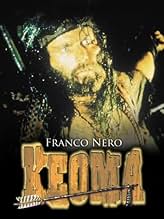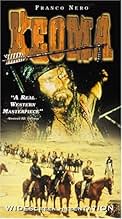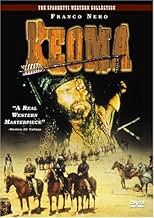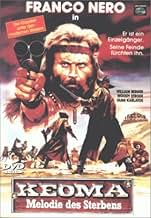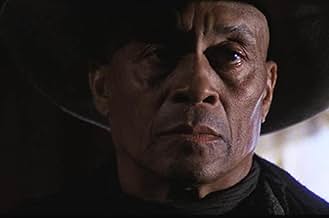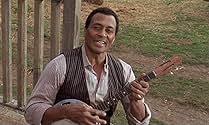IMDb-BEWERTUNG
7,0/10
6551
IHRE BEWERTUNG
Ein ehemaliger Revolverheld versucht, seine von der Pest heimgesuchte Heimatstadt vor der Übermacht seiner rassistischen Halbbrüder und eines konföderierten Tyrannen zu schützen.Ein ehemaliger Revolverheld versucht, seine von der Pest heimgesuchte Heimatstadt vor der Übermacht seiner rassistischen Halbbrüder und eines konföderierten Tyrannen zu schützen.Ein ehemaliger Revolverheld versucht, seine von der Pest heimgesuchte Heimatstadt vor der Übermacht seiner rassistischen Halbbrüder und eines konföderierten Tyrannen zu schützen.
Joshua Sinclair
- Sam Shannon
- (as John Loffredo)
Donald O'Brien
- Caldwell
- (as Donald O'Brian)
Leonardo Scavino
- Doctor
- (as Leon Lenoir)
Antonio Basile
- Caldwell's Henchman
- (Nicht genannt)
Giovanni Bonadonna
- Caldwell's Henchman
- (Nicht genannt)
Armando Bottin
- Caldwell's Henchman
- (Nicht genannt)
Aldo Canti
- Wagon Fugitive
- (Nicht genannt)
- …
Felice Ceciarelli
- Caldwell's Henchman
- (Nicht genannt)
Empfohlene Bewertungen
I have to pretty much agree with the two negative reviews below, and I'll explain why in a minute.
Franco Nero plays "Keoma" a half-breed Indian raised by a white man named Shannon (William Berger) who also has three sons (adoptive brothers of Keoma) who hate him and have never accepted a 'half-breed' as their brother.
There's also George (Woody Strode), an ex-slave and friend of Shannon's who teaches Keoma all he knows about fighting.
Cut 20 years later after some flashbacks and Keoma returns to the town near where he was raised and finds that a plague has engulfed the town with a quarantine imposed by a wealthy mine owner Caldwell (Donald O'Brien) who would just as soon have it's inhabitants all die off so he can fully control the area. Keoma steps in to save a pregnant woman who Caldwell's men suspect as a plague carrier and all hell breaks loose.
Yeah, some of the knife throwing does look ludicrous, but the fist fights look good and there's an excellent gun battle in town between Keoma, Shannon and George vs. Caldwell's men. It's really done well and it looks like it was filmed in the same western set built outside of Rome as DJANGO was ten years earlier. By this time though, the place looks pretty run down and cluttered which makes a good setting for a plague-infested town.
As far as negatives go, the music sucks. It's an annoying high pitch (mostly female) whine that appears periodically throughout the move, inter sprinkled with 'singing' done by Franco Nero himself. It sounds awful as he tries to imitate Leonard Cohen but winds up sounding like a lame Tom Waits. I don't know why anybody likes it. To each his own, I guess.
There's also the annoying Sam Peckinpah-like slow-motion effects that become a cliché used over and over. It ruins some of the great gunfights, especially at the end where Keoma is battling his brothers in a barn while the pregnant lady's screams drown out all the gun battle sound. A little too arty for my tastes.
The dubbing is OK and it sounds like Nero dubbed in his own voice which comes off as strange and foreign for a half-breed American Indian. I suppose one gets used to it as the film goes along.
The Anchor Bay DVD uses an anamorphic widescreen print that looks pretty good. Only a few scratches during the opening and closing titles. No closed captioning. Nero also does a 10 minute interview explaining how the film came about, along with a secondary audio track by director Enzo Castellari giving details about the filming. Yeah the spaghetti western genre was dead by the time this film was made, but Castellari says it did very well in Italy although not enough to revive the genre. Tastes were moving towards gangsters and crime dramas by the mid-70s, so this film was an exception, not the rule.
It has some good ideas but I wouldn't consider it a masterpiece for the genre or anything. However I did enjoy some of the gun play and fistfights.
6 out of 10
-
Franco Nero plays "Keoma" a half-breed Indian raised by a white man named Shannon (William Berger) who also has three sons (adoptive brothers of Keoma) who hate him and have never accepted a 'half-breed' as their brother.
There's also George (Woody Strode), an ex-slave and friend of Shannon's who teaches Keoma all he knows about fighting.
Cut 20 years later after some flashbacks and Keoma returns to the town near where he was raised and finds that a plague has engulfed the town with a quarantine imposed by a wealthy mine owner Caldwell (Donald O'Brien) who would just as soon have it's inhabitants all die off so he can fully control the area. Keoma steps in to save a pregnant woman who Caldwell's men suspect as a plague carrier and all hell breaks loose.
Yeah, some of the knife throwing does look ludicrous, but the fist fights look good and there's an excellent gun battle in town between Keoma, Shannon and George vs. Caldwell's men. It's really done well and it looks like it was filmed in the same western set built outside of Rome as DJANGO was ten years earlier. By this time though, the place looks pretty run down and cluttered which makes a good setting for a plague-infested town.
As far as negatives go, the music sucks. It's an annoying high pitch (mostly female) whine that appears periodically throughout the move, inter sprinkled with 'singing' done by Franco Nero himself. It sounds awful as he tries to imitate Leonard Cohen but winds up sounding like a lame Tom Waits. I don't know why anybody likes it. To each his own, I guess.
There's also the annoying Sam Peckinpah-like slow-motion effects that become a cliché used over and over. It ruins some of the great gunfights, especially at the end where Keoma is battling his brothers in a barn while the pregnant lady's screams drown out all the gun battle sound. A little too arty for my tastes.
The dubbing is OK and it sounds like Nero dubbed in his own voice which comes off as strange and foreign for a half-breed American Indian. I suppose one gets used to it as the film goes along.
The Anchor Bay DVD uses an anamorphic widescreen print that looks pretty good. Only a few scratches during the opening and closing titles. No closed captioning. Nero also does a 10 minute interview explaining how the film came about, along with a secondary audio track by director Enzo Castellari giving details about the filming. Yeah the spaghetti western genre was dead by the time this film was made, but Castellari says it did very well in Italy although not enough to revive the genre. Tastes were moving towards gangsters and crime dramas by the mid-70s, so this film was an exception, not the rule.
It has some good ideas but I wouldn't consider it a masterpiece for the genre or anything. However I did enjoy some of the gun play and fistfights.
6 out of 10
-
This film has so much that works so well, it's a shame one thing keeps it from working entirely l: the music. The single most annoying song I've ever heard in a film. Secondly the newest "restored" version inexplicably has two totally different English voices dubbed for Nero. His first few lines are delivered in a deep clear "radio announcer" pure English baritone, the rest of the film is in a poorly faked accent. What exactly would be the reason for this? Other than those two distractions, a great late era entry to the genre.
Director Castellari is nowadays perhaps best-known (if at all) by the younger generation of film buffs for one thing: making the original INGLORIOUS BASTARDS (1977), which Quentin Tarantino has been threatening to remake for years now. However, in my opinion, he should instead be remembered for making this impressive, belated Spaghetti Western gem.
An odd blend of violent action and heady mysticism apparently concocted by one of the credited screenwriters Luigi Montefiori (better known to hardened Euro-Cult fans as an actor under the alias of George Eastman) but, as star Franco Nero and Castellari himself state in the Anchor Bay DVD supplements, the script took so long to get written that they decided to work without one and make the dialogue up as they went along! That the end result is so satisfying (and practically unique in the subgenre) is a remarkable achievement in itself.
Keoma is a half-breed returning home from the American Civil War to find his hometown ravaged by the plague and overtaken by the villainous Caldwell (Donal O' Brien); among his cohorts are Nero's three half-brothers who had made his childhood a living hell, with his surrogate father (William Berger) and colored mentor turned banjo-playing town-drunk (Woody Strode) unable to do much to counter Caldwell's oppression. A Bergmanesque, cadaverous old woman is frequently seen roaming the streets dragging a cart behind her...
What follows is the typical confrontation between Good and Evil but Castellari infuses the familiar mixture with several directorial flourishes: occasionally striking compositions (particularly a memorably Fordian opening shot), frequent use of slow-motion in true Peckinpah-style, flashbacks in which Keoma is a spectator to his own past experiences (inspired by Elia Kazan's THE ARRANGEMENT [1969]!), a touch of elliptical editing, Christian symbolism (Keoma is crucified at one point) and, most distressingly of all, a folksy soundtrack (inspired by Leonard Cohen and Bob Dylan, no less and warbled...er...sung by a shrill, high-pitched female singer and an out-of-tune deep-voiced male) which narrates in song the action we're seeing on the screen. I say distressingly because the Guido and Maurizo De Angelis compositions found here have forever been a thorn in the side of even the film's staunchest admirers!! Personally, I didn't mind the female singer so much after a while but when her (possibly drunk) male companion took over in the last half hour, I was in for some cringe-inducing moments for sure...!
Despite these misgivings, the film is still one of the best Spaghetti Westerns out there (and certainly the last great example of the subgenre); its undoubted highlight is provided by a terrific, lovingly protracted action set-piece in which Nero, Berger and a reformed Strode (back to his former arrow-shooting glory - perhaps a nod to the role he played in Richard Brooks' splendid THE PROFESSIONALS [1966]) wipe out most of Caldwell's gang. Their triumph is short-lived, however, because both Berger and Strode lose their lives in the ongoing struggle (Berger poignantly so, while Strode's death scene is particularly great), with Nero almost bowing out himself under the strain of his siblings' torture - who have subsequently disposed of Caldwell and taken over the town themselves; the final confrontation, then, between Keoma and his three half-brothers is eerily set to the "strains" of Olga Karlatos' (playing a woman Keoma had earlier on saved from a plague-infested colony) wailing and screaming as she lies giving birth to a child amidst the carnage!
While at first I was disappointed that the Anchor Bay DVD only included the English dub, having watched it now it seems clear that the actors were all speaking their dialogue in English on the set - although, as connoisseurs will certainly know, this was all re-recorded back in the studios anyway (as was common practice in the Italian film industry). Still, if ever it gets shown again on Italian TV, I'll be sure to check it out just for completeness' sake. Thankfully, however, Castellari contributes a highly enthusiastic and informative Audio Commentary in which he discusses his major influences while making the film, among them Sidney J. Furie's THE APPALOOSA (1966), Altman's McCABE AND MRS. MILLER (1971) and Peckinpah's PAT GARRETT AND BILLY THE KID (1973).
Ultimately, Franco Nero in the title role is almost as iconic a figure as Django and, hopefully, I should be getting to another fairly obscure but highly intriguing Spaghetti Westen of his - Luigi Bazzoni's MAN, PRIDE AND VENGEANCE (1968), an eccentric updating of Georges Bizet's opera "Carmen", co-starring Klaus Kinski and Tina Aumont - pretty soon...
An odd blend of violent action and heady mysticism apparently concocted by one of the credited screenwriters Luigi Montefiori (better known to hardened Euro-Cult fans as an actor under the alias of George Eastman) but, as star Franco Nero and Castellari himself state in the Anchor Bay DVD supplements, the script took so long to get written that they decided to work without one and make the dialogue up as they went along! That the end result is so satisfying (and practically unique in the subgenre) is a remarkable achievement in itself.
Keoma is a half-breed returning home from the American Civil War to find his hometown ravaged by the plague and overtaken by the villainous Caldwell (Donal O' Brien); among his cohorts are Nero's three half-brothers who had made his childhood a living hell, with his surrogate father (William Berger) and colored mentor turned banjo-playing town-drunk (Woody Strode) unable to do much to counter Caldwell's oppression. A Bergmanesque, cadaverous old woman is frequently seen roaming the streets dragging a cart behind her...
What follows is the typical confrontation between Good and Evil but Castellari infuses the familiar mixture with several directorial flourishes: occasionally striking compositions (particularly a memorably Fordian opening shot), frequent use of slow-motion in true Peckinpah-style, flashbacks in which Keoma is a spectator to his own past experiences (inspired by Elia Kazan's THE ARRANGEMENT [1969]!), a touch of elliptical editing, Christian symbolism (Keoma is crucified at one point) and, most distressingly of all, a folksy soundtrack (inspired by Leonard Cohen and Bob Dylan, no less and warbled...er...sung by a shrill, high-pitched female singer and an out-of-tune deep-voiced male) which narrates in song the action we're seeing on the screen. I say distressingly because the Guido and Maurizo De Angelis compositions found here have forever been a thorn in the side of even the film's staunchest admirers!! Personally, I didn't mind the female singer so much after a while but when her (possibly drunk) male companion took over in the last half hour, I was in for some cringe-inducing moments for sure...!
Despite these misgivings, the film is still one of the best Spaghetti Westerns out there (and certainly the last great example of the subgenre); its undoubted highlight is provided by a terrific, lovingly protracted action set-piece in which Nero, Berger and a reformed Strode (back to his former arrow-shooting glory - perhaps a nod to the role he played in Richard Brooks' splendid THE PROFESSIONALS [1966]) wipe out most of Caldwell's gang. Their triumph is short-lived, however, because both Berger and Strode lose their lives in the ongoing struggle (Berger poignantly so, while Strode's death scene is particularly great), with Nero almost bowing out himself under the strain of his siblings' torture - who have subsequently disposed of Caldwell and taken over the town themselves; the final confrontation, then, between Keoma and his three half-brothers is eerily set to the "strains" of Olga Karlatos' (playing a woman Keoma had earlier on saved from a plague-infested colony) wailing and screaming as she lies giving birth to a child amidst the carnage!
While at first I was disappointed that the Anchor Bay DVD only included the English dub, having watched it now it seems clear that the actors were all speaking their dialogue in English on the set - although, as connoisseurs will certainly know, this was all re-recorded back in the studios anyway (as was common practice in the Italian film industry). Still, if ever it gets shown again on Italian TV, I'll be sure to check it out just for completeness' sake. Thankfully, however, Castellari contributes a highly enthusiastic and informative Audio Commentary in which he discusses his major influences while making the film, among them Sidney J. Furie's THE APPALOOSA (1966), Altman's McCABE AND MRS. MILLER (1971) and Peckinpah's PAT GARRETT AND BILLY THE KID (1973).
Ultimately, Franco Nero in the title role is almost as iconic a figure as Django and, hopefully, I should be getting to another fairly obscure but highly intriguing Spaghetti Westen of his - Luigi Bazzoni's MAN, PRIDE AND VENGEANCE (1968), an eccentric updating of Georges Bizet's opera "Carmen", co-starring Klaus Kinski and Tina Aumont - pretty soon...
Review of English-language Blue Underground version:
My, my these Spaghettis. In Keoma (Franco Nero), we have a man who has descended into hell, he has become an annihilator. The landscape is infernal, from the Breughelesque sets to the leering henchman to the blasted mountains. For his enemies, he has two barrels of a shotgun, and no pity. The hell is as much in his mind as it is in the town he rides into. He is a man with no place, ideology or purpose. Unlike Eastwood's characters in the dollars trilogy who are without history or neuroses, with Nero as Keoma we have a profound psychological portrait of a man in spiritual agony, on the road to obliteration and self-immolation.
The scenario is also hellish, we have a town and a region that has been taken over by a warlord. He and his henchman block access from and to the outside world. The townsfolk are all infected with a plague, and rather than given access to medical aid, they are put in a concentration camp and forced to mine for silver, or simply murdered. The town is left to the henchmen and their trollops. This for me is very unlike a western in the traditional American sense. In the American western, there are always the upright people of the town to appeal to, there is a sheriff, or as a last resort the cavalry. People may be run off their land or be claim-jumped, but they are never forced into slave labour.
What we have in Keoma, and in similar movies such as Django and Django Strikes Again, is a fundamentally African western, which is probably why Spaghetti goes down so well on that continent. The town in Keoma is more reminiscent of somewhere in Sierra Leone than the Sierra Nevada. There is total brutal oppression of the populace. There is a reckless attitude towards the value of life. Keoma is likewise a more fitting hero for such a landscape, he is almost a Christ-like figure in the sense that he is betrayed or deserted by everyone in this movie, his family, the oppressed, and the liberated. When Keoma is crucified on a wagonwheel the artisans, politicos, henchmen and whores celebrate a change of leadership in the saloon that was entirely down to him. He is constantly grimy, his hair is totally overgrown, he is hirsute, sweaty, and wears no overshirt. Seeing him shove his pistol down the back of his trousers against his bare back will make the ladies a little queasy.
This movie has a very dreamlike atmosphere. The reason for this is that there is no real cohesive plot. Apparently Castellari threw the script in the bin immediately prior to shooting and adopted a completely improvisational approach. The only consistency to the movie is that of image and emotion. Throughout the movie is laced with the anguish of haunted souls, and punctuated by the slow-mo killings after the fashion of Peckinpah. The improvisation can unfortunately be quite clear. Some of the actors were writing their own lines the night before shooting. The dialogue is not always brilliant to say the least, and it is not helped by Nero's far from accent-less English. However this is about the only film where improvisation could work, simply because it is entirely beneficial to the oneiric, logic-less atmosphere.
The De Angelis brothers' soundtrack will be interesting to some because of the untrained voices. Nero sings quite a lot of it himself, and you will have to suspend disbelief and accept it, because although the man clearly has no singing talent, there is an authenticity to his singing that is refreshing.
I'm not sure what Woody Strode was doing in this picture, but flashbacks of him shooting his bow add to the trippiness. Keoma the movie is not quite as far-out as something by Jodorowsky, but it's on the way.
My, my these Spaghettis. In Keoma (Franco Nero), we have a man who has descended into hell, he has become an annihilator. The landscape is infernal, from the Breughelesque sets to the leering henchman to the blasted mountains. For his enemies, he has two barrels of a shotgun, and no pity. The hell is as much in his mind as it is in the town he rides into. He is a man with no place, ideology or purpose. Unlike Eastwood's characters in the dollars trilogy who are without history or neuroses, with Nero as Keoma we have a profound psychological portrait of a man in spiritual agony, on the road to obliteration and self-immolation.
The scenario is also hellish, we have a town and a region that has been taken over by a warlord. He and his henchman block access from and to the outside world. The townsfolk are all infected with a plague, and rather than given access to medical aid, they are put in a concentration camp and forced to mine for silver, or simply murdered. The town is left to the henchmen and their trollops. This for me is very unlike a western in the traditional American sense. In the American western, there are always the upright people of the town to appeal to, there is a sheriff, or as a last resort the cavalry. People may be run off their land or be claim-jumped, but they are never forced into slave labour.
What we have in Keoma, and in similar movies such as Django and Django Strikes Again, is a fundamentally African western, which is probably why Spaghetti goes down so well on that continent. The town in Keoma is more reminiscent of somewhere in Sierra Leone than the Sierra Nevada. There is total brutal oppression of the populace. There is a reckless attitude towards the value of life. Keoma is likewise a more fitting hero for such a landscape, he is almost a Christ-like figure in the sense that he is betrayed or deserted by everyone in this movie, his family, the oppressed, and the liberated. When Keoma is crucified on a wagonwheel the artisans, politicos, henchmen and whores celebrate a change of leadership in the saloon that was entirely down to him. He is constantly grimy, his hair is totally overgrown, he is hirsute, sweaty, and wears no overshirt. Seeing him shove his pistol down the back of his trousers against his bare back will make the ladies a little queasy.
This movie has a very dreamlike atmosphere. The reason for this is that there is no real cohesive plot. Apparently Castellari threw the script in the bin immediately prior to shooting and adopted a completely improvisational approach. The only consistency to the movie is that of image and emotion. Throughout the movie is laced with the anguish of haunted souls, and punctuated by the slow-mo killings after the fashion of Peckinpah. The improvisation can unfortunately be quite clear. Some of the actors were writing their own lines the night before shooting. The dialogue is not always brilliant to say the least, and it is not helped by Nero's far from accent-less English. However this is about the only film where improvisation could work, simply because it is entirely beneficial to the oneiric, logic-less atmosphere.
The De Angelis brothers' soundtrack will be interesting to some because of the untrained voices. Nero sings quite a lot of it himself, and you will have to suspend disbelief and accept it, because although the man clearly has no singing talent, there is an authenticity to his singing that is refreshing.
I'm not sure what Woody Strode was doing in this picture, but flashbacks of him shooting his bow add to the trippiness. Keoma the movie is not quite as far-out as something by Jodorowsky, but it's on the way.
A half-breed Indian Keoma returns back to his hometown after fighting in the Civil War, and finds his town is being run by an ex-Confederate soldier Caldwell and his outlaws. He holds power over the town by letting the plague infect the inhabitants, and since he won't let any sort of treatment be transported in. He sets up a community for those infected, and this where Keoma rescues a pregnant woman on her way there and returns her back to town. His three half-brothers have joined Caldwell, and I don't think that highly of their brother's return. But loyalty to their father, they won't kill him. His father William Shannon and former family servant/only friend George eventually join Keoma to break the strangle hold Caldwell possess.
Whoa! How good? Real good. Director Enzo G. Castellari's grand looking and interesting spaghetti western comes across as a powerful and beautifully constructed Greek tragedy with a cynical and almost psychological edge bound to it. There's a bit everything chucked into this passionate and intelligent exercise. Breathing high on mood and atmosphere, photographer Aiace Parolin exquisitely frames the mercilessly brooding locations and Castellari's stylishly first-rate direction keeps the film sombre with a brutally unsparing and dirt-laced tone in its dramatic images and context. Good use of abstract lighting and composition, he knows how to keep the viewer at bay with slam-bang set pieces towards the end and a downbeat undercurrent. Inventive framing and exposition also shows the quality of his direction. The glorious slow-motion shootouts and editing technique (ala Sam Peckinpah) are dazzling and how about the constant jumping or leaping in the air. Was there a hidden trampoline on set?! Everything about it held a nice rhythm to it and you just get swept along. Even the flashback sequences are positioned in the story accordingly and in a fulfilling style. The lyrical story is full of symbolic and thematic issues (freedom being the main focal point) that do pack a punch, but also showing a vulnerable side. This gave it a real singular vibe to set it apart from the crowd. Hell, I didn't mind the uncanny and soaring ballad soundtrack too. The way it actually interlocked with the film's sequences, I thought it gave the film some soul and a backbone (well other than always charismatically reliable Nero). A rugged Franco Nero was outstanding. Both mentally and psychically in his scrappy determination and seldom figure Keoma. The impressively committed Woody Strode was excellent. William Berger brought class, and Olga Karlatos decently balanced out an innocent side that really was moving. Donald O'Brien nails it down in a starch turn as the villainous Caldwell.
Whoa! How good? Real good. Director Enzo G. Castellari's grand looking and interesting spaghetti western comes across as a powerful and beautifully constructed Greek tragedy with a cynical and almost psychological edge bound to it. There's a bit everything chucked into this passionate and intelligent exercise. Breathing high on mood and atmosphere, photographer Aiace Parolin exquisitely frames the mercilessly brooding locations and Castellari's stylishly first-rate direction keeps the film sombre with a brutally unsparing and dirt-laced tone in its dramatic images and context. Good use of abstract lighting and composition, he knows how to keep the viewer at bay with slam-bang set pieces towards the end and a downbeat undercurrent. Inventive framing and exposition also shows the quality of his direction. The glorious slow-motion shootouts and editing technique (ala Sam Peckinpah) are dazzling and how about the constant jumping or leaping in the air. Was there a hidden trampoline on set?! Everything about it held a nice rhythm to it and you just get swept along. Even the flashback sequences are positioned in the story accordingly and in a fulfilling style. The lyrical story is full of symbolic and thematic issues (freedom being the main focal point) that do pack a punch, but also showing a vulnerable side. This gave it a real singular vibe to set it apart from the crowd. Hell, I didn't mind the uncanny and soaring ballad soundtrack too. The way it actually interlocked with the film's sequences, I thought it gave the film some soul and a backbone (well other than always charismatically reliable Nero). A rugged Franco Nero was outstanding. Both mentally and psychically in his scrappy determination and seldom figure Keoma. The impressively committed Woody Strode was excellent. William Berger brought class, and Olga Karlatos decently balanced out an innocent side that really was moving. Donald O'Brien nails it down in a starch turn as the villainous Caldwell.
Wusstest du schon
- WissenswertesThe story line of the film was mostly improvised at the same time as the film was made. The original story treatment was written by Luigi Montefiori (aka George Eastman) and turned into a script by Mino Roli and Nico Ducci, but director Enzo G. Castellari didn't like what had been written by the latter two. Because of problems with the schedule, Castellari and actor Joshua Sinclair wrote the script for the next day every evening after filming of the day. Castellari was also open to suggestions from the cast and crew - Franco Nero has confirmed that he wrote some of his own dialogue.
- PatzerAt 7:08 riders on horseback in pursuit of two men running on foot fire their pistols. Both men on foot react as if hit by the first shot.
- Alternative VersionenGerman version was cut for violence and pacing reasons by 8 minutes to secure a "not under 16" rating. Despite that, it still got put on the index list by the BPjM which means various sales and advertising restrictions. Fortunately in 2003, the movie was removed from the index list and the FSK granted the uncut version a "not under 16" rating.
- VerbindungenFeatured in L'oeil du cyclone: Westernissimo (1995)
- SoundtracksKeoma
(uncredited)
Music by Guido De Angelis & Maurizio De Angelis
Lyrics by Susan Duncan Smith and Cesare De Natale
Performed by Sibyl Mostert and Cesare De Natale
Top-Auswahl
Melde dich zum Bewerten an und greife auf die Watchlist für personalisierte Empfehlungen zu.
- How long is Keoma?Powered by Alexa
Details
Zu dieser Seite beitragen
Bearbeitung vorschlagen oder fehlenden Inhalt hinzufügen

Oberste Lücke
By what name was Keoma - Melodie des Sterbens (1976) officially released in India in English?
Antwort

